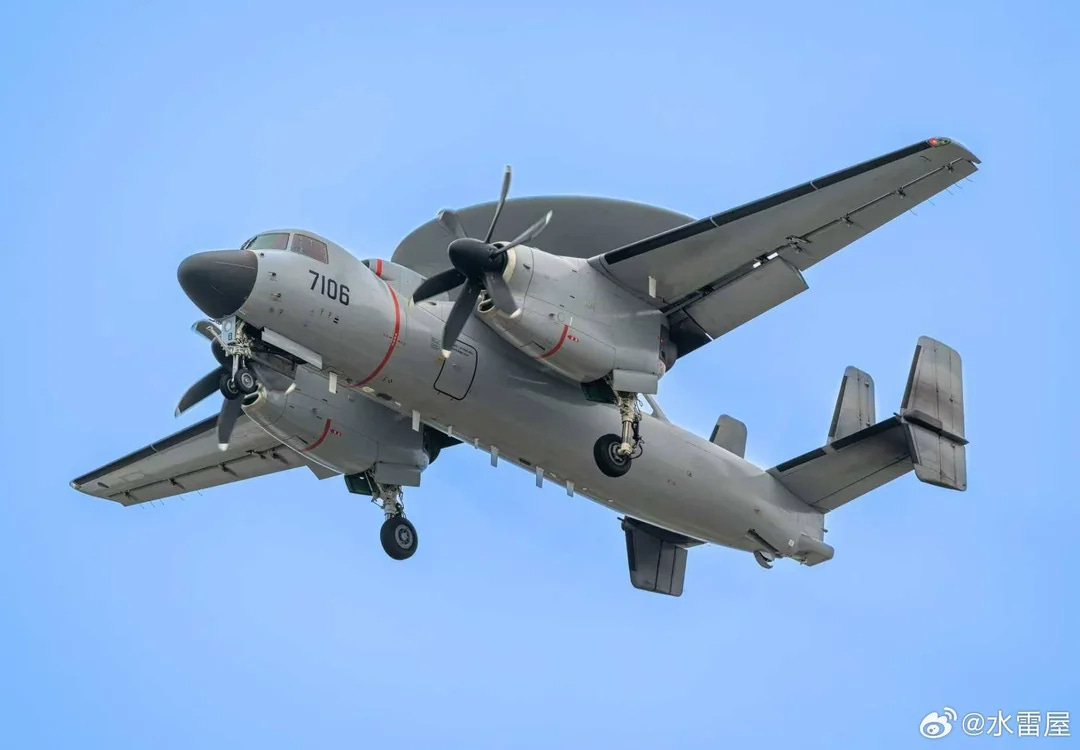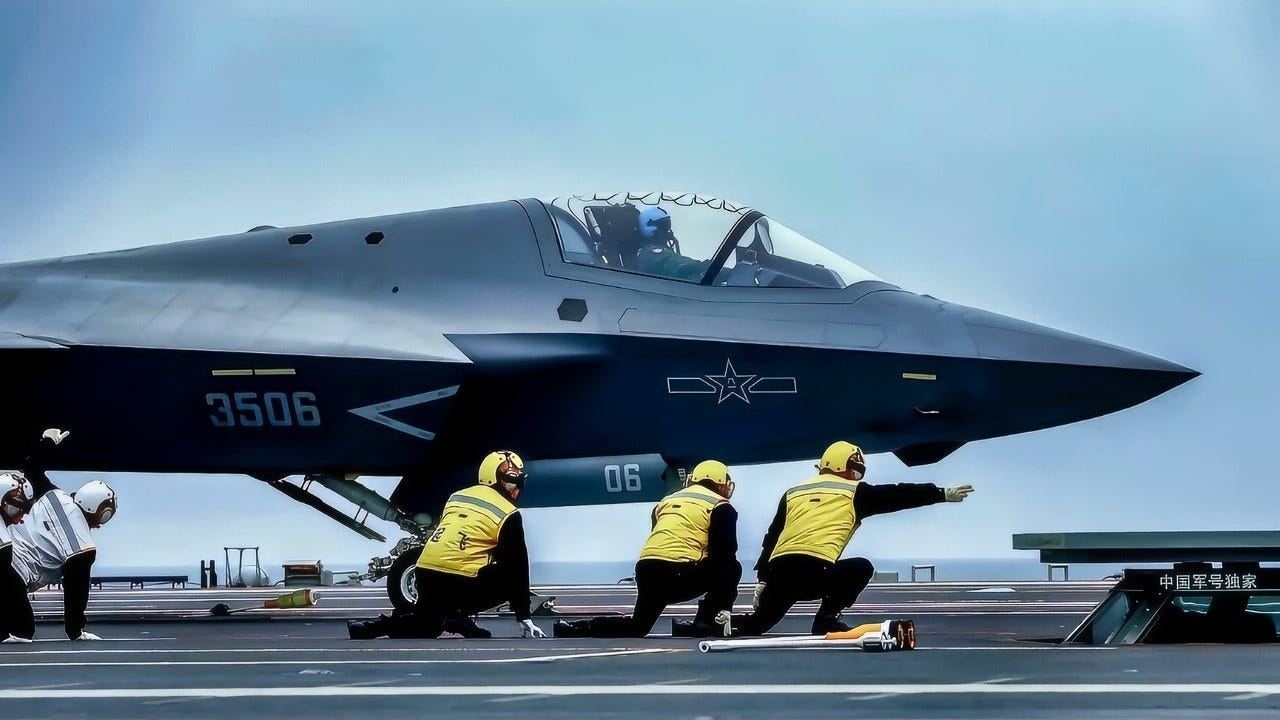The Only Post You Need to Read on China’s New Carrier
Type 003 Fujian
Type 003 Fujian’s Technical Capabilities
The 001 and 002 are smaller, with displacements of 60k and 70k tons, respectively. The 003 Fujian is about 80k without a full complement. The 003 should be able to carry twice as many aircraft (about 70-80) as previous models since most of the extra displacement can be used to increase hangar capacity.
The three electromagnetic catapults can launch heavier aircraft, including the KJ-600 (空警-600 / Kong Jing / Air Warning-600) airborne early warning aircraft, and the J-35 (歼击机-35 / Jian Ji Ji / Fighter-35).
KJ-600
The KJ-600 fills a role similar to the US Navy E-2D Advanced Hawkeye, a plane with multiple radars to gain airborne (or surface) awareness, pass targeting information, control air and missile defense, and potentially jam or conduct electronic warfare. Modern air combat is difficult, if not impossible, without supporting airborne radar planes quarterbacking the air fight.
J-35
The J-35 is supposedly a 5th generation fighter. While its avionics, radars, and missiles are certainly an upgrade from the existing J-15 carrier fighter, it remains to be seen if the J-35’s stealth works well, something the PLA has not yet achieved. The J-35 does have internal weapons bays to preserve stealth. Regardless, it should be better all around than the lowly J-15.
Simply by being commissioned recently, the 003 will have better radar, networking, and C2 capabilities than the 001 and 002.
The 003 is indigenously designed and built. Expect either more 003 class under construction to build out the carrier fleet or a jump to a 004 nuclear-powered supercarrier. Or both. Based on build and test time, if the PLA dual-tracks carrier builds, in about 15 years, the PLAN could be operating four more carriers, gaining ground on the US Navy’s current 11-carrier force.
What These Capabilities Mean
The 001 Liaoning and 002 Shandong are not real carriers. They can barely achieve more than 40 aircraft sorties a day. Compare this to the US Gerald Ford, which can launch 100 sorties a day at peak ops (the Ford’s numbers will likely improve in the future).
The J-15 Flying Sharks launched from the 001 and 002 are already terrible fighter attack aircraft, and they cannot take off with full fuel and weapons due to the lack of catapults. This severely limits the J-15’s strike range and ability to provide defense in depth to the carrier. The 001 and 002 cannot launch strikes at a long enough range to prevent the carriers from being targeted and destroyed.
These limiting factors do not apply to the 003. First, the 003’s ability to launch the J-35 should give it much enhanced situational awareness. Looking through the J-15’s radar is like looking through a soda straw to identify targets.
The J-35 should have a 5th gen wide area surveillance radar that soaks in data for hundreds of miles, painting an intelligence picture that can be fed to the 003’s command center or parsed to other platforms. The J-35 can do this at a longer range than the J-15, allowing for the 003 to have the minimum distances it needs to protect itself.
Second, the 003 can launch a new version of the Flying Shark called the J-15T. This new version has an AESA (active electronically scanned array) radar, a significant leap from the previous model.
J-15T landing. Background J-35 and Z-9 Helictoper
This means that a J-15T can launch with full fuel and a full load of large external weapons from the 003. Once airborne, its more sophisticated avionics and radar should be able to receive targeting data from the KJ-600, J-35, or the carrier itself, allowing it to launch large external long-range weapons (that cannot fit in the J-35’s internal weapons bays) at a distance. The J-15T can provide long-range fire support to the J-35 or strike surface targets at safer distances for the 003.
Third, the KJ-600 provides the minimum capability a PLA Navy carrier wing needs to survive and conduct missions. The KJ will have the best PLAN airborne radar by far.
This should allow it to track thousands of targets, maintaining situational awareness of the fight. The KJ should be able to prioritize engagement targets and work with other aircraft or surface warships to target and destroy them. The KJ can also track incoming threats, allowing them to be defeated by the same means.
This also applies to submarines, with assistance from anti-submarine warfare helicopters the 003 will carry. With the KJ-600, the 003 can actually see what is going on and defend itself.
The 003 should actually be a viable carrier.
The 003’s endurance means that cruising range for peacetime exercises comfortably extends to the Alaska, Hawaii, Australia, or the Maldives regions. However, under wartime conditions (high speeds, evasive maneuvers, constant launches, submarine patrols), this range shrinks down to the first and second island chains. The 003 brings the PLAN a little closer to a regional blue water capability, but global operations remain outside the PLA’s reach.
Cost
This is an audacious gamble. Deploying a single carrier is not effective. It requires cruisers, destroyers, submarines, oilers, auxiliary ships, national technical means, and extensive training.
The immense cost of the growing PLA naval fleet will induce a maintenance and repair overhang in the following decades. The daily upkeep, periodic maintenance, and cost of repairs for warships has been staggering since the age of the trireme.
Naval forces are fundamentally different than ground forces. A world-class navy requires the largest and most complex platforms humanity creates (with the possible new exception of semiconductor fabrication plants), and they do not come cheap.
The CCP could perhaps sustain these costs if it only required a small professional army. Yet the modern Chinese state has never maintained a large navy due to the overriding requirement to deploy a massive army necessary to secure mainland China’s borders and suppress the domestic population.
Therefore, the CCP seeks to maintain one of the largest armies in the world while building the largest navy in the world - something only the Romans have accomplished.
Of course, the CCP may simply be planning to deploy these vessels in anger (or have them sink) in less than 15 years. The breakneck speed of the PLA Navy buildup makes more sense if Beijing believes it will never have to seriously maintain these vessels.
Arms Racing
Naval arms races are surprisingly risky, with only the US/UK winning these contests since 1588. That’s over 400 years of Anglo-American maritime supremacy. Historically, naval buildups have caused international order to steer into highly volatile territory.
Some examples include the Athenian, Roman, Ottoman, Monarchical French, Imperial German, and Imperial Japanese naval buildups. These buildups all destabilized international relations and ended in the failure of the rising power, with the exception of the Roman Republic.
The CCP is taking its existence into its own hands with such a naval buildup. This signals a much higher appetite for risk, something Washington can exploit.
Limitations
The limiting factors of carriers are severe in modern wargaming. In most rules systems, the threat of long-range cruise missiles and anti-ship ballistic missiles is extremely high.
The PLA Rocket Force can launch land-based anti-carrier ballistic missiles (DF-21D, DF-26) or hypersonic glide vehicles (DF-17), which are highly effective at achieving mission kill or destruction of a US carrier strike group. The US is deploying systems superior to those the PLA fields after leaving the Intermediate Nuclear Forces Treaty, which blocked American development of such systems until 2019.
The US can launch stealthy long-range anti-ship cruise missiles (LRASM / AGM-158C) from stealth bombers, which clean up PLA Navy surface ships, including carriers. This capability will be greatly enhanced after the B-21 Raider is fielded, and the PLA Air Force is developing a similar system in the H-20.
This means the utility of aircraft carriers in a Pacific fight is extremely curtailed. The continued focus on and construction of carriers by the US Navy and PLA Navy has at least as much to do with bureaucratic politics as it does with combat capability.
However, the US will still need to invest in new classes of weapons and purchase more LRASMs to counter the growing PLAN carrier fleet.
Perhaps the PLAN carrier fleet is not intended to combat the US directly, but rather to protect the PRC’s global sea lanes and trade interests. While this is somewhat rational, the cost is enormous if the CCP believes it must first confront the US before taking its place as one of the superpowers.
Conclusion
Yes, the 003 is the PLAN’s first real carrier. But the significance is mostly in the tactical and operational details. Strategically, the PLA does not require carriers to attempt to control the first island chain or invade Taiwan.
At the grand strategic level, the CCP is taking on breathtaking risks by financing a large navy and arms racing with the US, all based on investing in a class of ships last employed in serious naval combat during WWII.
Maybe Washington and Beijing are not the greatest strategists.




